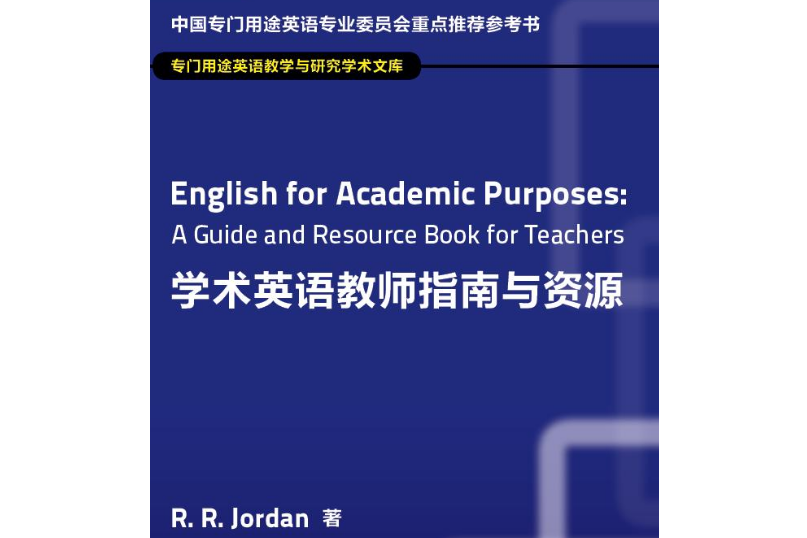內容簡介
本書作者R. R. Jordan是英國EAP(English for Academic Purposes)學派著名學者,是上世紀70年提倡EAP概念的主要人物。本書為學術英語教師提供全面深入的闡述。不僅關注學術英語的教學技巧,同時涉及有關EAP的其他諸多核心理念,如需求分析、教學大綱與課程設計、教學法、教學資源、學習風格、測評與考試、學術風格與體裁分析,等等。除了通用學術英語,本書作者還關注特定學科的語言和教學資源。 本書的讀者對象是EFL教師(母語或二語)、ELT/ESP教師和套用語言學者,旨在為讀者提供EAP理論研究基礎及有關實踐指導。
目錄
Contents
List of figures x
List of abbreviations xi
Acknowledgements xii
Introduction xvii
Partl English forAcademic Purposes and study skills 1
Chapterl EAPand study skills: definitions and scope 1
1.1 What is English for Academic Purposes (EAP)? 1
1.2 What are study skills? 6
1.3 The native speaker and study skills 8
1.4 Study skills books for native speakers of
English 14
1.5 Introspect and discuss 18
Chapter 2 Needs analysis 20
2.1 An imaginary case study (1) 20
2.2 Analysis 22
2.3 Questions 22
2.4 Approaches to needs analysis 23
2.5 Summary 38
2.6 An imaginary case study (2) 41
2.7 Introspcct and discuss 41
Chapter 3 Surveys: students difficulties 43
3.1 Surveys: a note of caution 43
3.2 Overview 44
3.3 Spoken English and seminars 45
3.4 Academic writing 46
3.5 Lectures and note-taking 50
3.6 Reading 50
3.7 Experience and expectations 52
3.8 Introspect and discuss 53
Chapter 4 EAP syllabus and course design 56
4.1 EAP syllabus 58
4.2 Types of syllabus 60
4.3 Conclusion 63
4.4 EAP course design 64
4.5 An alternative course design: projects 67
4.6 Pre-sessional EAP courses 69
4.7 In-sessional, part-time courses 70
4.8 Long EAP courses 71
4.9 EAP course components 73
4.10 Content of EAP components 74
4.11 Non-EAP components 75
4.12 Timetabling: priorities, balance and structure 77
4.13 Timetable examples 79
4.14 International EAP courses 79
4.15 Introspect and discuss 83
Chapter 5 Evaluation: students and courses 85
5.1 Test' and `examination' 85
5.2 Tests: differences 85
5.3 Tests: types 86
5.4 Tests: general features 88
5.5 Feedback 89
5.6 Introspect and discuss 93
Chapter 6 Learning styles and cultural awareness 94
6.1 An imaginary case study (3) 94
6.2 Learning styles and strategies 95
6.3 Academic culture 98
6.4 General culture 103
6.5 British studies 106
6.6 Conclusion 107
6.7 Introspect and discuss 108
Chapter 7 Methodology and materials 109
7.1 Methodological principles 109
7.2 Principles of learning 110
7.3 Principles of communicative methodology 111
7.4 Communicative activities 111
7.5 Authenticity 113
7.6 Case studies, role-play and simulations 114
7.7 Individualisation and autonomy 116
7.8 Awareness-raising and learner training 117
7.9 Team-reaching 121
7.10 The role of the teacher 122
7.11 Some pedagogical principles 123
7.12 Conclusion 124
7.13 Introspect and discuss 125
Chapter 8 Evaluating materials 127
8.1 Choice of books 127
8.2 Integrated study skills books: comparative
content 128
8.3 Factors to compare 130
8.4 Listening and note-taking 132
8.5 Writing 132
8.6 Dictionaries 134
8.7 Evaluation: some questions 135
8.8 Criteria: checklists 137
8.9 Conclusion 138
8.10 Introspect and discuss 139
Part II Study skills and practice (EGAP) 141
Chapter 9 Academic reading 143
9.1 Strategies and skills 143
9.2 Categorising reading courses 144
9.3 Reading for information 145
9.4 Reading speed 146
9.S Reading comprehension and vocabulary 147
9.6 Introspect and discuss 147
ChapterlO Vocabulary development 149
10.1 Which vocabulary? 150
10.2 Second language vocabulary acquisition 153
10.3 Semantic field theory and componential
analysis 154
10.4 Teaching/learning vocabulary 156
10.5 Concordancing 159
10.6 Memory and mnemonics 161
10.7 Conclusion 162
10.8 Introspect and discuss 162
Chapterll Academic writing 164
11.1 The product approach 165
11.2 The process approach 167
11.3 Summarising, paraphrasing and synthesising 170
11.4 Feedback and evaluation 171
11.5 Conclusion 176
11.6 Introspect and discuss 177
Chapterl2 Lectures and note-taking 179
12.1 Lecturing styles and lecture structure 181
12.2 Listening cues 183
12.3 Informal language 186
12.4 Taking notes 187
12.5 Lecture length 190
12.6 Conclusion 190
12.7 Introspect and discuss 191
Chapterl3 Speaking for academic purposes 193
13.1 Lectures 193
13.2 Seminars 195
13.3 Oral presentations 201
13.4 Verbalising data 204
13.5 Individual speech diffculties 205
13.6 Conclusion 206
13.7 Introspect and discuss 206
Chapterl4 Reference/research skills 208
14.1 Dictionaries 208
14.2 Books 212
14.3 Using the library 213
14.4 References 214
14.5 Conclusion 217
14.6 Introspect and discuss 218
Chapterl5 Examination skills 219
15.1 Question analysis 219
15.2 Writing practice 221
15.3 Revision 225
15.4 Conclusion 225
15.5 Introspect and discuss 226
PartIII English for Specific Academic Purposes 228
Chapterl6 Academic discourse and style 228
16.1 Register analysis 228
16.2 Discourse analysis 229
16.3 Genre analysis 230
16.4 Hedging/vague language 240
16.5 Appropriacy 243
16.6 Conclusion 247
16.7 Introspect and discuss 247
Chapter 17 Subject-specific language 249
17.1 Students' inadequacy in the specialist subject 250
17.2 The EAP tutor and the subject specialist 251
17.3 Other concerns 252
17.4 Suggestions for teaching 252
17.5 ESAP books 256
17.6 Example of economics 257
17.7 Introspect and discuss 257
Chapterl8 Materials design and production 259
18.1 Against and for 259
18.2 Team writing 261
18.3 Recommended background reading 262
18.4 The need 262
18.5 Variables 264
18.6 Materials: suggestions 266
18.7 Possible problems in materials writing 269
18.8 Conclusion 270
18.9 Introspect and discuss 270
Chapterl9 Concerns and research 272
19.1 Concerns 272
19.2 What is research? 274
19.3 Action research 274
19.4 Research methods 275
19.5 EAP research areas 276
19.6 Conclusion 279
19.7 Introspect and discuss 280
Appendices 282
Index of appendices 282
I Recommended books and jurnals 283
2 Educational technology 350
3 BALEAP, and the Survey 359
4 EAP exams and examining bodies 362
References 365
Subject index 391
Author index 399

